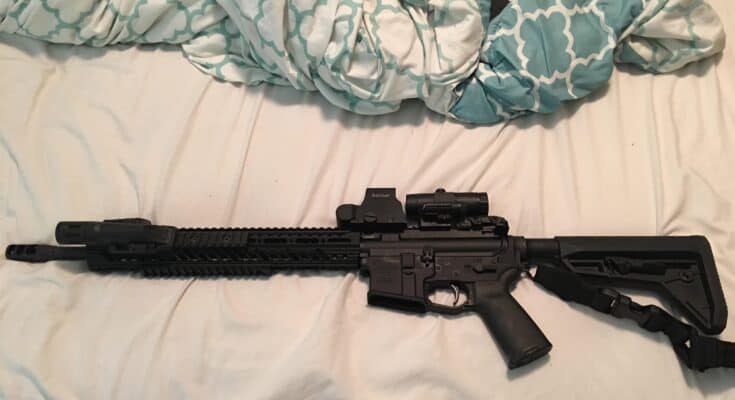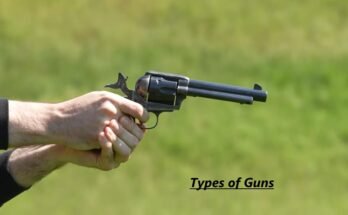A free-float handguard is a rifle component that doesn’t touch the barrel, enhancing accuracy. It’s essential for precision shooters.
Free-float handguards have become popular in the shooting community. They offer significant benefits over traditional handguards by improving accuracy and consistency. By eliminating contact with the barrel, they reduce external pressures that can affect the barrel’s harmonics. This leads to more precise shots, which is crucial for competitive shooters and hunters.
Free-float handguards also provide a stable platform for mounting accessories like scopes, lasers, and bipods. Whether you need one depends on your shooting goals. If precision and versatility are your priorities, investing in a free-float handguard could be a wise decision.

Credit: www.reddit.com
Introduction To Free-float Handguards
Free-float handguards have gained popularity among firearm enthusiasts. They offer numerous advantages for shooters. This section provides an introduction to free-float handguards.
Definition
A free-float handguard is a type of rifle handguard. It does not touch the rifle’s barrel. This design improves accuracy. The handguard attaches only to the rifle’s receiver. This eliminates pressure points on the barrel.
Free-float handguards offer a stable platform. Accessories like optics and lasers can be mounted easily. They also provide better heat dissipation. This keeps the barrel cooler during long shooting sessions.
Historical Background
Free-float handguards have evolved over time. They were first used in precision shooting competitions. Shooters needed more accuracy. Traditional handguards were not sufficient. Engineers developed the free-float design. This eliminated the barrel’s contact with the handguard.
Military and law enforcement agencies adopted the design. They required better accuracy in tactical situations. Today, free-float handguards are common in many rifles. They are popular in both civilian and professional use.
| Aspect | Traditional Handguard | Free-Float Handguard |
|---|---|---|
| Barrel Contact | Yes | No |
| Accuracy | Lower | Higher |
| Heat Dissipation | Lower | Higher |
| Accessory Mounting | Limited | Versatile |
- Better accuracy due to no barrel contact
- Versatile mounting for accessories
- Improved heat management for the barrel
Components Of A Free-float Handguard
A free-float handguard offers better accuracy for your rifle. Knowing its components can help you make an informed choice. Below, we will explore its material types and design features.
Material Types
Free-float handguards come in various materials. Each material offers unique benefits. Here are the common types:
- Aluminum: Lightweight and durable. Ideal for most shooters.
- Carbon Fiber: Extremely light and strong. Great for reducing weight.
- Polymer: Affordable and light. Suitable for budget builds.
Choosing the right material depends on your needs and preferences.
Design Features
Design features affect the functionality of your handguard. Here are key features to consider:
| Feature | Benefit |
|---|---|
| Picatinny Rails | Allow attachment of various accessories. |
| M-LOK Slots | Offer more customization options. |
| KeyMod Slots | Provide a sleek and lightweight design. |
| Length | Determine the coverage and protection. |
Consider these design features to match your shooting style. A well-chosen handguard can enhance your shooting experience.
Benefits Of Using A Free-float Handguard
A free-float handguard offers multiple benefits for shooting enthusiasts. It enhances your shooting experience and provides several advantages over traditional handguards. Let’s explore these benefits.
Accuracy Improvement
A free-float handguard helps improve accuracy. It does not touch the barrel, reducing any added pressure. This separation allows the barrel to vibrate freely, leading to more consistent shots.
The free-float design minimizes interference. It ensures that your shots are more precise. This is crucial for long-range shooting and competitive events.
Reduced Barrel Stress
Traditional handguards can add stress to the barrel. This stress can lead to inaccuracies. A free-float handguard eliminates this issue. It attaches to the receiver, not the barrel.
The reduced stress helps in maintaining the barrel’s integrity. It ensures longer barrel life and better performance. This is especially beneficial for high-volume shooters.
Installation Process
Installing a free-float handguard can seem challenging. With the right tools and instructions, it becomes easy. This section guides you through the installation process step-by-step.
Tools Required
- Armorers Wrench
- Torque Wrench
- Allen Wrenches
- Bench Vise
- Upper Receiver Action Block
- Barrel Nut
- Thread Locker
Step-by-step Guide
- Secure the upper receiver in the bench vise using the action block.
- Remove the existing handguard and barrel nut using the armorers wrench.
- Apply thread locker to the new barrel nut threads.
- Hand-tighten the new barrel nut onto the upper receiver.
- Use the torque wrench to tighten the barrel nut to the recommended torque.
- Align the gas tube hole with the receiver’s gas tube port.
- Install the gas tube through the barrel nut and into the receiver.
- Slide the free-float handguard over the barrel and align it with the barrel nut.
- Secure the handguard to the barrel nut using the provided screws and Allen wrenches.
- Double-check all connections for stability and proper alignment.
With these steps, your free-float handguard will be securely installed. Enjoy the improved accuracy and performance!
Comparing Free-float Vs. Drop-in Handguards
Choosing the right handguard for your AR-15 is crucial. Two popular options are free-float and drop-in handguards. Both serve the purpose but offer different benefits. This section compares their performance and ease of installation.
Performance Differences
Free-float handguards do not touch the barrel. This design reduces pressure and vibration. This can improve accuracy. Many shooters prefer free-float handguards for this reason. They are ideal for precision shooting.
Drop-in handguards are easier to install. They attach to the barrel and gas block. This can cause some pressure on the barrel. For casual shooters, the difference in accuracy may be minor. Drop-in handguards are often less expensive.
Ease Of Installation
Installing a free-float handguard can be challenging. It usually requires special tools. You may need to remove the barrel. This can be time-consuming. Many choose to have a gunsmith do it.
In contrast, a drop-in handguard is simple to install. Most can do it at home. No special tools are needed. This makes it a popular choice for beginners.
| Feature | Free-Float Handguard | Drop-In Handguard |
|---|---|---|
| Accuracy | Higher | Moderate |
| Installation | Harder | Easier |
| Cost | Higher | Lower |
| Tools Needed | Special Tools | No Special Tools |
Choosing between a free-float and drop-in handguard depends on your needs. If you seek better accuracy, consider a free-float handguard. If ease of installation and cost matter more, a drop-in handguard is a good choice. Both have their place in the AR-15 community.

Credit: www.reddit.com
Popular Brands And Models
Choosing the right free-float handguard can be challenging. There are many brands and models to consider. Some brands offer excellent quality and features. Knowing the popular ones can help you make an informed decision.
Top Manufacturers
Several manufacturers are renowned for their free-float handguards. Here are some of the top names:
- Aero Precision: Known for their precision and durability.
- Midwest Industries: Offers a wide range of handguards.
- Daniel Defense: Recognized for military-grade handguards.
- BCM (Bravo Company Manufacturing): Famous for high-quality materials.
- Geissele Automatics: Offers robust and reliable options.
Customer Reviews
Customer reviews provide valuable insights. Here’s what users are saying:
| Brand | Model | Rating | Customer Feedback |
|---|---|---|---|
| Aero Precision | ATLAS S-ONE | 4.8/5 | Lightweight and easy to install. |
| Midwest Industries | G3 M-Series | 4.7/5 | Great build quality and finish. |
| Daniel Defense | MFR XL | 4.9/5 | Very sturdy and reliable. |
| BCM | Alpha KMR | 4.8/5 | Top-notch materials and construction. |
| Geissele Automatics | MK8 | 4.9/5 | Highly durable and dependable. |
Considerations Before Buying
Before buying a free-float handguard, there are several factors to consider. These factors will help you make an informed decision. You need to look at your budget, compatibility, and other essential aspects. Let’s dive into these considerations.
Budget
Budget is a crucial factor. Free-float handguards come in various price ranges. You can find affordable options and high-end ones. Decide how much you want to spend. Here are some price categories:
- Low-end: $50 – $100
- Mid-range: $100 – $200
- High-end: $200 and above
Determine your budget before shopping. This helps narrow down your options. Remember, more expensive doesn’t always mean better. Find the best value within your budget.
Compatibility
Compatibility is another key factor. Ensure the handguard fits your rifle. Check the specifications of your firearm. Look for the proper length and attachment type. Free-float handguards come in different lengths:
- Carbine length: 7 inches
- Mid-length: 9 inches
- Rifle length: 12 inches
Make sure the handguard matches your gas system. Some handguards require specific tools for installation. Verify if you need any special equipment. Compatibility ensures a secure and functional fit.
| Factor | Consideration |
|---|---|
| Budget | Decide how much you want to spend |
| Compatibility | Ensure the handguard fits your rifle |
By considering these factors, you can make a smart choice. Your free-float handguard will enhance your shooting experience.

Credit: www.reddit.com
Do You Need A Free-float Handguard?
A free-float handguard is a popular upgrade for many firearm enthusiasts. It promises better accuracy and a sleek look. But, do you actually need one? This section will help you decide.
Use Case Scenarios
Not every shooter will benefit from a free-float handguard. Here are a few scenarios where it might be useful:
- Precision Shooting: Ideal for those who need pinpoint accuracy.
- Competitive Shooting: Essential for a competitive edge.
- Long-Range Shooting: Helps in hitting distant targets.
- Custom Builds: Perfect for those who like to customize their firearms.
Pros And Cons
To help you further, let’s break down the pros and cons of a free-float handguard:
| Pros | Cons |
|---|---|
|
|
Deciding on a free-float handguard depends on your specific needs. Review your use cases and the pros and cons to make an informed decision.
Frequently Asked Questions
What Is A Free-float Handguard?
A free-float handguard is a rifle accessory. It attaches directly to the rifle’s upper receiver. This design prevents barrel contact. It enhances accuracy and consistency.
How Does A Free-float Handguard Improve Accuracy?
A free-float handguard minimizes barrel pressure. This reduces barrel flex during firing. It leads to better shot precision. Consistent accuracy is achieved through this design.
Do I Need A Free-float Handguard For My Rifle?
It depends on your shooting needs. If you seek better accuracy, it’s beneficial. It’s ideal for competitive shooting and long-range accuracy.
Are Free-float Handguards Difficult To Install?
Installation varies by model. Some require gunsmithing skills. Others are user-friendly with simple tools. Always follow manufacturer instructions for best results.
Conclusion
A free-float handguard can enhance your shooting experience by improving accuracy and reducing weight. It is an excellent upgrade for any firearm enthusiast. Evaluate your needs and consider investing in this versatile component. Ultimately, choosing the right handguard can significantly impact your shooting performance and overall satisfaction.



